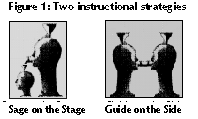
Copyright 1996 CAUSE. From CAUSE/EFFECT Volume 19, Number 3, Fall 1996, pp. 14-21. Permission to copy or disseminate all or part of this material is granted provided that the copies are not made or distributed for commercial advantage, the CAUSE copyright and its date appear, and notice is given that copying is by permission of CAUSE, the association for managing and using information resources in higher education. To disseminate otherwise, or to republish, requires written permission. For further information, contact Julia Rudy at CAUSE, 4840 Pearl East Circle, Suite 302E, Boulder, CO 80301 USA; 303-939-0308; e-mail: [email protected]
Networking technologies offer a better learning environment for students while providing opportunities for reducing the cost of the learning process. A key outcome of advances in networking, the Internet, telecommunications, and client/server computing is that they are serving to alter the limitations of time and place. The authors discuss their experiences from the perspective of teaching in economics and the arts. They have created learning strategies that make use of these technologies for communication and access according to a matrix showing the interaction of time and place.
A paradigm shift is taking place in higher education. According to Barr and Tagg, the paradigm that has governed our colleges and universities is one that defined a college or university as "an institution that exists to provide instruction. Subtly but profoundly we are shifting to a new paradigm: a college is an institution that exists to produce learning." We are beginning to recognize
that our dominant paradigm mistakes a means for an end. It takes the means or method--called "instruction" or "teaching"--and makes it the college's end or purpose... We now see that our mission is not instruction but rather that of producing learning with every student by whatever means work best.1
In this article, we address the following questions: Will computing and networking technologies offer a better learning environment for students? Will these technologies improve our ability to help students produce learning while reducing the cost of instruction? We believe that the answer to these questions is a resounding "yes," if computing and networking technologies are used to create learning strategies that involve students as active partners in their own learning.
In the search for active learning strategies, we are guided by two principles stated by Cobb:
Our goal as teachers in using computing and networking technologies is, to use a metaphor, to be a "guide on the side" instead of a "sage on the stage." To return to Barr and Tagg's terminology, our goal is to move from an instruction paradigm, in which a faculty member's role is "actor" and knowledge is transferred from faculty to students, to a learning paradigm, in which a faculty member's role is "inter-actor--a coach interacting with a team," and students discover knowledge for themselves.3 We illustrate these contrasting paradigms in Figure 1.4

Networking and Internet connectivity is critical to our teaching strategies. To create an Internet Web presence for both courses, we set up a Web server on Macintosh computers directly connected to the Internet through a 16 MB token ring. WebStar (originally MacHTTP) was used as the Web server and FTPd was used to create file transfer and Gopher services. A key advantage to this configuration is that folder or directory access is easily administered through AppleShare, and student folders can be accessed either through the local AppleTalk networks or through file transfer over the Internet. The server for music was upgraded to UNIX and an SGI Indy computer this past year. Listservs, Usenet newsgroups, and e-mail were created through the campus Internet servers for these operations. Both of us have available personnel for technical support to assist with setting up and maintaining the servers and accounts; however, we did much of this ourselves.
The network and server facilities that we have in place provide for our students, to use Larry Smarr's phrase, a "window into knowledge space."5 Smarr asserts that we are experiencing today the fruits of a major transition from a world of one person, one computer, to a world of the "meta- computer," a computer of computers. In this new world, a personal computer becomes a "window into knowledge space" and a gateway to virtual resources. But meta-computing does more than provide a looking glass through which to see the world. We believe that meta-computing also creates a looking glass that reflects back to the learner an image of him- or herself working with other learners. Meta-computing enables learning by providing diverse modes of communication and access to a creative, virtual collaborative space for students.
Here is just a sample of some of the learning activities possible in our networked, meta-computing environment at Illinois State University:
In the remainder of this article, we present examples of how we implement these activities in our classes. We find it useful to view these activities in terms of a time-and-place matrix, a concept developed from writings on groupware strategies and adapted to our work.6 A key outcome of the advances in computer networking and the Internet is that they are serving to alter the limitations of time and space. Each cell in the matrix (see Figure 2) demonstrates this by representing unique combinations of time and place events in fully networked learning environments. We start with same- time/same-place (representing the traditional classroom) and progress clockwise through different-time/different-place.
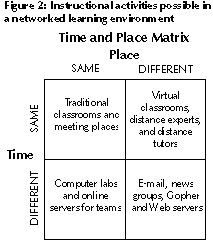
Most efforts at incorporating technology into instruction have been focused on this cell of the matrix. This cell includes any meta-computing learning strategy that improves the ways in which students traditionally learn within the confines of meeting for fifty minutes, three times per week (same time), in the same classroom (same place). Such strategies include collaborative or groupware applications and experiences, in-class demonstrations, practical experiences (especially with simulations), experiences with software applications, and in-class access to student and course online files. The economics course makes use of simulation and in-class electronic collaboration and feedback within the same-time/same-place cell of the time-place matrix. The fine arts courses use the computer for demonstration, hands-on practice, and critique of student work within this cell.
The ASA's last recommendation presents a seeming conundrum. How can students gain an intuitive understanding of the concepts of probability by eschewing its formal study? Answer--through the use of computer simulation. Economics students learn the central idea of statistics through a series of Monte Carlo simulation experiments. From their computer workstations in class, each student generates twenty random samples of the same size from the same population and for each sample calculates the mean and median. They then send the instructor an e-mail message which contains their twenty means and medians. The instructor then combines each student's response with the responses of the other students and then e-mails these class distributions of the means and medians back to the students for further analysis.
The economics courses use e-mail and a class listserv to augment an active learning strategy called "think-pair- share." This activity takes place collaboratively during class time. To help students clarify their thinking, the instructor asks each student to write an e-mail message to the class listserv, explaining, in words their fellow students will understand, a particularly difficult concept, a p-value for example. Students then read what other students have written and discuss differences or similarities with their teammates. The advantage of the listserv in this context is that students know that their message is sent to the entire class. This version of "think-pair-share" is based on Meyers and Jones' observation that "when we direct students to write to each other, they usually write with more clarity and precision."8
The economics courses also use network computing to provide frequent feedback on the quality of student learning through a technique called the "Minute Paper."9 A typical Minute Paper asks students to respond, in the final minute or two of class, to two questions: (1) What is the most important thing you learned today, and (2) What is the muddiest point still remaining at the conclusion of today's class?
The first question is intended to focus students on the big picture, i.e., what is being learned, and the second to provide specific statements of what students want to know more about, i.e., how well it is being learned. At the conclusion of every class, students in the economics courses answer these questions plus a set of Likert-scale questions developed by Shulman10 using a Netscape form (see Figure 3). 11 The form creates a tab-delimited text file of the students' responses, which can be easily analyzed in Excel and Minitab. Furthermore, because the form also asks students to provide their e-mail addresses, the instructor can respond immediately via e-mail to any student who seems particularly "muddy."
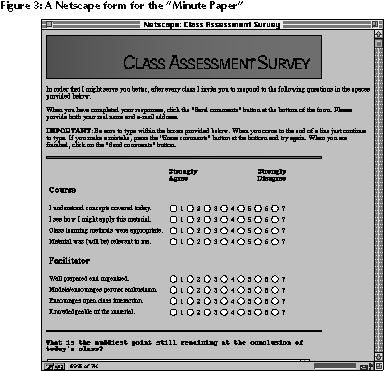
Before the next class, the economics instructor analyzes students' feedback and fashions an e-mail message back to the students that contains their verbatim responses to the Minute Paper from the previous class. Students find this practice informative because it tells them, in unabridged language, that other students are muddy about the same points as they. The instructor begins the subsequent class with a discussion of students' responses, in essence, with feedback on student feedback.
The instructor uses the teaching workstation and its connection to the network to quickly access student work from the department server, where class and private student folders permit electronic storing of assignments and work in progress. Students have an online folder for their work to which only they and the instructor have access. Having electronic access to all student projects makes it easy to quickly show and compare portions of students' work and to isolate examples of problem areas in software and instructional development that need class attention. When hands-on training is needed for learning new software development tools, the portable lab-on-wheels can be rolled into the classroom.
We both use a series of Web pages to organize online course content, where materials dedicated to our courses are stored.13 Students can find electronic versions of handouts and course syllabi. The well-worn plea for another copy of a lost handout is now followed by the rejoinder of "just download a new copy from the class server." Grades are posted electronically after each assignment for those students who give the instructor permission to post grades. We make a GIF graphic image of a class spreadsheet and post it in the class server space, where only the students in the class have access for downloading.
The fine arts instructor provides each student with a private folder where only that student and the instructor can gain access to the materials. Special "drop folders" are created for submitting work electronically; files can be "dropped" in, but only the instructor can take them out. The instructor also creates online folders for each class project where students can share the results of their work with the class, and for the Internet Models course, with the Internet community at large. In fact, the instructor requires his students to announce their completed projects on the Internet newsgroups and invite the public to electronically critique and react to their work. (See figure 4 for an example of student work.)
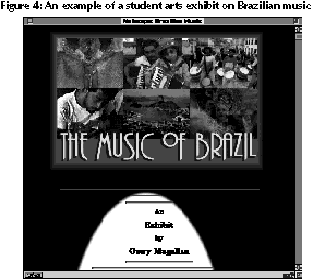
A local Usenet newsgroup is created just for the class; this serves as an electronic bulletin board for the students and the instructor. Posts for help, advice, announcements, helpful tips, and coordinating student teamwork all circulate through the class newsgroup over the semester. We believe that a listserv would provide a more controlled environment for a collective newsgroup over the Internet. Listservs are a good way to implement online critiques of work where several on-campus classes participate, or better still, where the same class on several different campuses shares work electronically.
Electronic mail, of course, is the most widely used different-time/different-place technology. With extensive use of e-mail for both students and faculty at Illinois State University, we have found that it has a great social-leveling or equalizing effect. Interaction with people anywhere in the world through only text frees the exchange from biases that can be caused by visual appearances. We have found that students are much more likely to seek help from the instructor via e-mail than to make an appointment to see him or her in an office. We have also found that students are more likely to seek help from each other or from anyone in the world through e-mail. One student convinced Guy Kawasaki15 to help him with his assignment simply because Mr. Kawasaki was impressed and intrigued by the way the student presented the problem to him; another student managed to get help with multimedia copyright law by convincing a Harvard law student, through e-mail, to find the copyright information in the Harvard library.
Other examples of using networks for different time/different place collaboration include electronic newsletters and journals, and electronic forums or listservs and Usenet news servers.
The instructor also uses online newsgroups and e-mail extensively in his class. Students are encouraged to use e- mail to communicate and collaborate with each other, and with the instructor. Through a combination of e-mail and newsgroups, students begin to think in terms of the learning process and the course of study being a twenty-four-hour-a- day, seven-days-a-week experience, rather than a fifty- minute-a-day, three-days-a-week experience; students, the instructor, and peers and experts worldwide are always within reach.
Student work is submitted electronically through the class drop folders, and all work is critiqued with feedback being returned electronically to the student through e-mail. Figure 5 shows a sample e-mail critique. A standard template is used for each project that emphasizes the key objectives and criteria for the project. With online course materials, electronic submission of work, and e-mail critiques, no hardcopy or paper work exchanges hands in the fine arts courses (except for the class registration list and grade submission, which still use op-scan forms)!
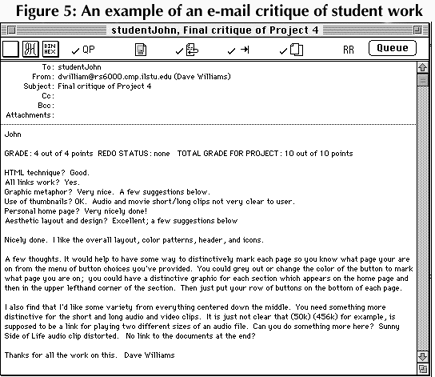
Notice that we state the question in terms of the cost of learning per student rather than in terms of the cost of instruction per student. In this distinction, we agree with Barr and Tagg when they say, "Under the Learning Paradigm, producing more with less becomes possible because the more that is being produced is learning and not hours of instruction. Productivity, in this sense, cannot even be measured in the Instruction Paradigm college. All that exists is a measure of exposure to instruction."16
This distinction is not the usual ploy of defining away the problem, but rather of defining the problem properly in the first place. If we take learning as the proper metric, then we have no choice but to adopt learning strategies that produce active, involved learners. The lecture-discussion, the primary means of producing instruction in American colleges and universities, does produce a lower cost of instruction than active learning strategies. But we have increasing evidence that the lecture-discussion is ineffective at producing learning. As stated by Guskin, "the primary learning environment for undergraduate students, the fairly passive lecture-discussion format where faculty talk and most students listen, is contrary to almost every principle of optimal settings for student learning."17
Put more positively, there is increasing evidence that the model of what constitutes good practice in higher education is changing. Already there is ample evidence that the two most important determinants of learning are time-on-task and active learning strategies.18 As a consequence, asking whether active learning strategies produce instruction at lower cost than the lecture-discussion, asks the wrong question. Rather we should be asking whether the learning produced, by whatever strategy, can be produced more efficiently. Here is where technology enters the picture.
As we have shown, networked computing--and in particular meta-computing--can be used to adapt already proven active learning strategies and produce the same or increased learning less expensively. In terms of what? Primarily in terms of faculty time.
As faculty ponder whether to adopt active learning strategies, they rationally compare costs and benefits. From a faculty member's perspective, the cost of the technological backbone is a sunk cost. The sunk nature of the backbone is illustrated in a Doonesbury cartoon.19 Mike Doonesbury engages a colleague in the following dialogue:
Mike: Hank, what's a Web site?
Hank: It's an Internet presence.
Mike: What's on it?
Hank: It doesn't matter. Build it and they will come.
Mike: Why do we need one?
Hank: Because the technology exists. Also, everyone else has one.
Mike: What's my motivation?
Hank: Fear. Greed. Take your pick.
Universities have built it, but will faculty come? As we have emphasized, there are two issues here: first, persuading teachers to switch from an instruction to a learning paradigm, from the sage-on-the-stage to the guide-on-the- side, and second, giving them the necessary training to gain competence with networking and Internet technologies. As to the former issue, as the new model of good practice in higher education becomes more widely held, we believe that faculty members will seek out ways of incorporating these domains into their teaching. And they will do so using technology because, as we have shown, technology can be used to produce learning at lower variable cost in terms of faculty time.
As to the latter issue, the fine arts program at Illinois State University serves as a model. Several full-time staff provide ongoing training for various computer skills, including Internet applications, for faculty and students. However, the philosophy has always been a bottom-up approach. The best exemplars are those faculty who have learned to use technology, even in small ways, and can show examples of how these technologies were used in their classroom and curriculum. The fine arts program provides many opportunities for faculty to share what they are doing with each other. The other key ingredient is providing ample rewards for the significant extra time it takes to learn new territory. The College of Fine Arts provides stipends for technology development and for taking courses related to technology skills.
Perhaps Doonesbury is correct, and the only motivation to change is "fear and greed." But we rather hope that the motivation lies in a deeply felt understanding that the raison d'etre of a college or university is not to produce instruction but rather to produce learning, and that a technology-enhanced, active, collaborative approach to learning is an answer.
1Robert B. Barr and John Tagg, "From Teaching to Learning- A New Paradigm for Undergraduate Education," Change, November/December 1995, 13.
2George Cobb, "Teaching Statistics," in L. A. Steen (ed.), Heeding the Call for Change: Suggestions for Curricular Action, MAA Notes No. 22 (Washington DC.: Mathematical Association of America, 1992), 20.
3Barr and Tagg, 24.
4These figures were digitally created by David B. Williams from an original graphic of a sage-on-the-stage-like image by an unknown artist. We have not been able to identify the source of this image.
5Larry Smarr, taken from an interview on a NOVA PBS series on supercomputing and networking. See http://141.142.3.134/Cyberia/MetaComp/MetaHome. html for a good presentation on "metacomputing."
6See Robert Johansen, "An Introduction to Computer Augmented Teamwork," in Robert P. Bostrom, Richard T. Watson, and Susan T. Kinney (eds.), Computer Augmented Teamwork (New York: Van Nostrand Reinhold, 1992); and David B. Williams and Peter R. Webster, Experiencing Music Technology (New York: Schirmer Books, 1996).
7Joan Garfield and Andrew Ahlgren, "Difficulties in Learning Basic Concepts in Probability and Statistics: Implications for Research," Journal for Research in Mathematics Education 19 (1988): 46.
8Chet Meyers and Thomas Jones, Promoting Active Learning: Strategies for the College Classroom (San Francisco: Jossey- Bass Publishers, 1993), 25.
9Thomas A. Angelo and K. Patricia Cross, Classroom Assessment Techniques: A Handbook for College Teachers (San Francisco: Jossey-Bass Publishers, 1993), 148.
10Gary Shulman, "A Computerized Quality Assessment Tool for the Classroom," paper delivered at the 10th AAHE Conference on Assessment and Quality, Boston, 1995.
11The Netscape form is only the latest incarnation of the Minute Paper. Chizmar migrated from asking students to respond to the Minute Paper first using paper and pencil and then using e-mail. The primary advantage of using the form is that it substantially reduces the analysis time-from over one hour to less than 15 minutes.
12Allan J. Rossman, "Televisions, Physicians, and Life Expectancy." Journal of Statistics Education 2 (1994).
13Course materials for the fine arts class can be viewed at http://www.orat.ilstu. edu/CAUSE/inetModels/InternetModels.html, and for the economics class at http://www.econ.ilstu.edu/Jack_Chizmar/ECO131/Eco131home2.htm l
14Examples of the work from the Internet Models course can be viewed through Netscape at http://www.orat.ilstu.edu/CAUSE/inetModels/exhibits95.html and http://www.orat.ilstu. edu/CAUSE/inetModels/exhibits96.html. The student Brazilian music example in Figure 4 is used by permission of Gerry Magallan, Arizona State University.
15Guy Kawasaki was one of the key individuals responsible for the successful introduction of the original Macintosh computer in 1984. He founded Fog City Software in 1994 and is currently an Apple Fellow (see http://wais.sensei.com.au/archives/macway/kawasaki.html).
16Barr and Tagg, 23.
17Alan Guskin, "Reducing Student Costs and Enhancing Student Learning, Part II: Restructuring the Role of the Faculty," Change , September/October, 1994, 6.
18Peter T. Ewell and Dennis P. Jones, Indicators of "Good Practice" in Undergraduate Education: A Handbook for Development and Implementation (Boulder, Colo.: National Center for Higher Education Management Systems, 1996), 19-27.
19Captions are from a United Press Syndicate Doonesbury cartoon by G. B. Trudeau (28 November, 1995).
John F. Chizmar ([email protected]) is Professor of Economics at Illinois State University in Normal, Illinois. From 1986 to 1991 he served Illinois State University as Associate Vice President for Business and Finance. Before that, he served as Acting Associate Provost and Dean of Instruction. Dr. Chizmar has been working with computer- assisted instruction since the early 1970s.
David Williams ([email protected]) is Associate Dean for Research and Technology, Director of the Office of Research in Arts Technology, and Professor of Music in the College of Fine Arts, Illinois State University in Normal, Illinois. In the 1980s he established the Office of Research in Arts Technology (ORAT) at Illinois State to promote the use of computer-based technology in the arts and arts education. He is co-author of the textbook Experiencing Music Technology, published by Schirmer Books